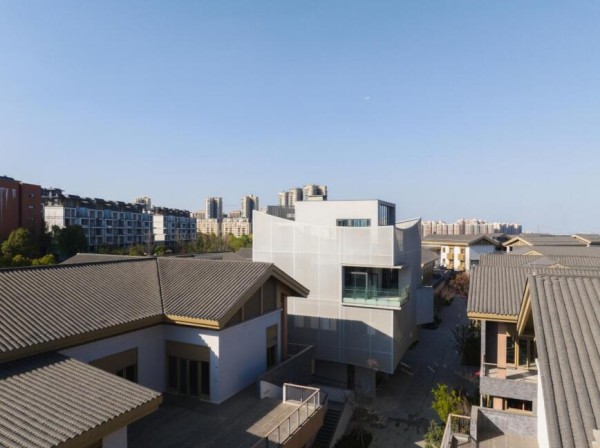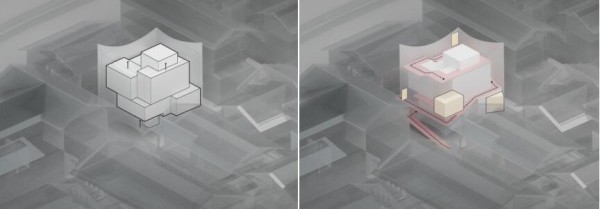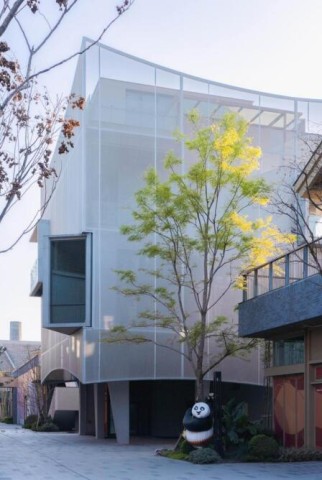At the end of 2023, “Tianfu Fiery Town” in Chengdu, China, claimed the top spot in urban hot searches for the season, emerging as a new landmark in the cultural tourism development of the southwestern region. The overall project planning for Boiling Town was designed by ORIA, which also crafted a landmark building within the town – the Kongming Lantern.

Chengdu, seemingly a city with a laid-back and somewhat jazzy pace on the surface, possesses an underlying passion, suggesting that the name “Tianfu Fiery Town” might be more fitting when reversed as “Fiery in the Bones.” Wenbo Wu, Chief Architect and Design Lead at ORIA, commented, “Chengdu has left me with the impression of a leisurely place; its urban temperament is unique and charming. Therefore, the initial concept for the entire ‘Tianfu Fiery Town’ project was to evoke a smoky flavor. In the project planning, we sought to convey this through two main axes, with the ‘Arid Thoroughfare’ representing ‘rationality’ and the ‘Aquatic Boulevard’ representing ‘sensibility.’ The Aquatic Boulevard is wider, and the Arid Thoroughfare is narrower, with various nodal spaces interspersed along these axes showcasing works expressing the spiritual essence of Chengdu by several outstanding domestic architects. Additionally, numerous interconnected alleys between the two main axes carry the splendor originating from fragments of my childhood memories in Rongcheng – stalls at the alley entrance, seats against the wall, old trees extending into the courtyard, halls with doors at both ends that can open, and platforms on the second floor overlooking the courtyard…”

The “Kongming Lantern” building is situated at the heart of the “Tianfu Fiery Town”, positioned in the center of the Arid Thoroughfare. Wenbo Wu’s design vision aimed to create an open space amidst the streets and alleys, necessitating a building that gives the appearance of being “floating,” thereby freeing the space below. This concept inspired the design of the “Kongming Lantern.”
Wenbo Wu explained, “Chengdu leaves people with a pleasant, relaxed, and comfortable impression. Thus, we opted to craft a building that is slightly off-kilter, light, and comfortable to resonate with its essence.” In this context, “light” pertains to visual lightness, while “floating” refers to the visual appearance of levitation. Through this metaphor, the urban atmosphere and spiritual state of Chengdu are articulated, presenting a floating, semi-transparent luminous structure, as if the Kongming Lantern is suspended in the air, radiating a sparkling and translucent light.

The entire building comprises five main components: a plaza formed by the elevated ground floor, designed to gather the flow of people; internally dynamic and diverse spaces that offer various scales of spatial experiences; an upward spiraling circulation connecting each distinct scale of space; and lightweight structural elements that define the overall external form of the building. Ultimately, a decision was made to adopt a semi-transparent and tidy exterior to subtly showcase these rich internal elements.

For Wenbo Wu, the sudden popularity of the original design fundamentally stems from the architect’s desire to articulate his perspectives on something or a place through the language of architecture, similar to how writers employ words, painters use brushes, and musicians use music. He expressed, “Self-expression holds significant importance for me. The distinction lies in that other forms of artistic expression are more centered on pure self-expression, while architectural expression revolves around my comprehension and emotions towards a city, a place, or a space. The joy of creation resides in this. The allure of original design serves as the impetus behind my pursuit of a career in architecture.”

From the design to the completion of this cultural tourism project, it represents a tangible manifestation of ORIA’s architectural philosophy. This involves abstractly summarizing the perception and understanding of traditional spatial scales and then employing modern methods to reorganize space, achieving a mapping effect. The identity of a neighborhood encompasses not only the form of the buildings themselves but also the memories, rhythms, and spirit of a city.
A locale like “Tianfu Fiery Town” and an architectural creation like the “Kongming Lantern” have now been witnessed by the entire internet, integrating local culture into the cultural tourism project in Southwest China. Those eagerly anticipating this moment are sure to share Wenbo Wu’s expectation for the day when the “Kongming Lantern” illuminates, ascending from the square and hovering in the air, casting a gentle glow.
From a literary perspective, the metaphor of “light” signifies a spiritual aspiration, symbolizing people’s admiration or pursuit of a certain ideal. The design concept of the “Kongming Lantern” essentially embodies the spirit of a place. As it is tied to a specific location, it is, to some extent, unique. However, the design concept associated with a place is the objective we have been striving for; it is something that can be “replicated.” If given the opportunity to create another “light,” Wenbo Wu envisions it as a lighthouse in a harbor, even more dazzling, guiding one’s way forward.
Media Contact
Company Name: ORIA
Contact Person: Lori
Email: Send Email
Country: China
Website: http://www.ori-a.com